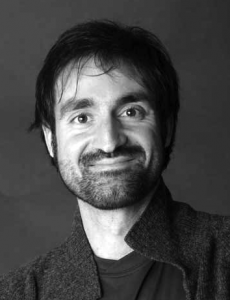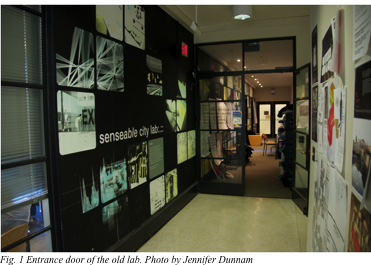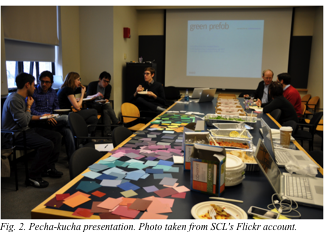Luca Simeone and Carlo Ratti
SENSEable City Lab (SCL) is a research initiative at the Massachusetts Institute of Technology (MIT) aimed at investigating and anticipating the ways digital technologies are changing the way people live and their implications at the urban scale (1). The SCL is nested within the City Design and Development group at the Department of Urban Studies and Planning and has had an ongoing collaboration with the MIT Media Lab. Over the past 7 years roughly 350 collaborators, representing more than 60 different scientific disciplines (from architecture, urban studies and planning, civil and mechanical engineering to theology, game programming, Russian studies, medieval studies, sport, music, space science, Asian arts, economy of culture and many others) have collaborated on SCL’s projects. With its transdisciplinary, context-driven, problem-focused approach, the lab truly embodies what has been defined as ‘Mode 2’ knowledge production practice (Gibbons et al. 1994). A practice that involves multi-disciplinary teams brought together for short periods of time to work on specific, complex problems in the real world, thus exploring new ways of developing the competency of transdisciplinary collaboration.
This article is an account of an ethnographic study conducted at SENSEable City Lab over a period of four months from February to May 2011. The study was particularly focused on SENSEable City Lab’s organizational culture of transciplinarity.
This short paper is the result of a dialogic interpretation of the results of the full study, a conversational process between Luca Simeone – the cultural anthropologist who led the ethnographic analysis – and Carlo Ratti – SENSEable City Lab’s founder and director.
Overview of the Research Project
SENSEable City Lab acts as an initiative that coagulates multiple creative streams and productive energies coming from in-house transdisciplinary researchers and external collaborations with other institutions, laboratories, companies. Along these reactive and agile joints, SENSEable City Lab generates disruptive work that spans from architectural interventions, such as The Cloud, an architectural system for the city of London, to innovative product design, such as The Copenhagen Wheel, a responsive system that transforms ordinary bicycles into hybrid sensors/actuators that provide feedback on pollution, traffic congestion and road conditions in real-time, or to future sensing technologies, such as TrashTrack, an initiative that used hundreds of small location-aware tags to track different types of trash to reveal the final destination of our everyday objects (and the waste management practices behind the removal process).
As students, scholars and practitioners are a part of these projects they weave their own personalized trajectories, patrolling the frontiers of different disciplines, pioneering new methods and practices and building learning structures in a sort of mathetics in action (2).
SENSEable City Lab therefore represents a unique observation landscape and we decided to carry out an ethnographic study in order to trace the key components of SENSEable City Lab’s organizational culture that favor its transdisciplinary.
Scientific literature on trasdisciplinarity has followed different approaches: while some authors have insisted on the idea of transdisciplinarity as a continuous and enriching transit among different disciplines in order to grasp the multiple dislocations of contemporary life (Gibbons, Limoges, et al. 1994; Nowotny, Scott, and Gibbons 2001), others have adopted a more integrated perspective (Nicolescu 2002; Max-Neef 2005) grounded on new science paradigms (Wheatley 2006). Max-Neef synthesizes this approach by stating: “Transdisciplinarity, more than a new discipline or super-discipline is, actually, a different manner of seeing the world, more systemic and more holistic” (Max-Neef 2005, 15).
For the purpose of this study, we decided to focus on the operational dimension of transdisciplinarity in the design field: an intersectional meander located at the crossroads of theory and practice. Several studies – such as the recent collection edited by Doucet and Janssens (2011) – have reported on the important relation between transdisciplinarity and design: knowledge production in design, architecture and urbanism is strictly tied to the integration of discipline and profession that follows a designerly mode of inquiry. Transdisciplinarity seems to be a productive approach for designers who want to tackle perplexing and complex real-world problems.
Within this context our main interest was to explore SENSEable City Lab’s organizational culture behind transdisciplinarity. From a relational perspective, organizational culture is a set of assembled codes and artifacts temporarily objectified but always susceptible to critical and creative recombination by individuals and their social life (Weick 1979). Therefore a research approach based on organizational culture theories has to take into consideration this variety of interpretations studying how stakeholders create meanings in organizations through their understanding of events, actions, interactions within physical spaces and organizational realities (Gioia, Schultz, and Corley 2000). In this sense, SENSEable City Lab’s physical components (geographic location, buildings, furnishings), organizational dimensions (relationships among stakeholders, rules, policies, processes and practices, management system) and cultural narratives (values and assumptions behind the organization, personal biographies) shape (and are shaped by) the laboratory’s organizational culture.
Key Elements of SENSEable City Lab’s Organizational Culture
- The front door of the lab is almost always open during the day. Lab members and collaborators constantly flow in and out. The lab follows extremely flexible engagement processes: hundreds of people have collaborated with SENSEable City Lab’s projects over time, some of them for longer periods while others only for a limited period of time (even for merely a few weeks); some of the members live in Cambridge and have a specific (or exclusive) engagement with the lab, some others collaborate on a part-time basis, maintaining their affiliations with other MIT departments, other universities, other research centers or come from the industry or government bodies. The lab also relies on a widely distributed network of collaborators scattered across several countries.
- In organizational terms, SENSEable City Lab is not structured as a bureaucratic pyramid with a traditional vertical reporting system. Small teams are the key elements of a more flexible organizational order. Each team is in charge of one or more projects. Some of the projects have a pre-set outcome and a clearly specified deadline. Others start as ideas that get shaped along the way and therefore are initially oriented towards less defined outcomes. Projects’ lifetimes span from few weeks (e.g. the preparation for a TED talk) to several months or years (e.g. The Copenhagen Wheel, Live Singapore!).
- The number of members per team varies from few people for smaller projects (e.g. The wireless city, Spacebook, GEOblog) to several dozens (e.g. the Digital Water Pavilion, TrashTrack). In the past five years, more than 300 people have worked with one of these teams on SENSEable City Lab’s projects.
- Although there are some management roles (Carlo Ratti, Assaf Biderman, Kristian Kloeckl) that are transversal to the entire group, teams are usually the key units for managing all these projects. A network of authority and control based on knowledge of the task replaces the traditional hierarchical structure. Within the team, tasks and responsibilities are distributed depending on the available personal expertise and the operational context. Mutual adjustment and redefinition of tasks are common within and across teams.
- The organizational structure literally emerges from the interweaving of processes carried out by these distributed teams. A complex horizontal and vertical integration is constantly reshaped as a relational configuration drawn together by internal connectedness and emergent behaviors. Order is not imposed from the top down but appears as teams work together responding to internal and external inputs and changes.
- Teams are usually managed by a team leader. This is not a rule that applies to all projects, though bigger projects tend to have a project leader. Team leaders are generally not professionals specifically trained in project management techniques but members of the lab who have knowledge and competencies for the task. Since some projects have a longer lifespan, there are cases where different project leaders have been in charge during different phases of the project. Teams are usually started and initially shaped by the lab’s senior members but the distribution of roles is flexible: during my stay several new projects were introduced to the lab’s members at the Tuesday lunch meetings and people were invited to nominate themselves if they thought that they could contribute to them.
- Membership within the lab and among the teams is extremely fluid. Short and part-time engagements with flexible roles over time are rather common. The lab’s current members reflect a combination of academic and professional competences. Some people collaborate at a distance, while others from the lab in Cambridge.
- The organizational culture is also very effective in creating an environment where people think that they can give a significant contribution. The flexible structure of the lab and the subsequent decentralization of power across horizontal connections create a sort of ‘distributed ownership’: people know that they are contributing to influencing the lab in a significant way.
- Ownership and trust mechanisms are also built through some important organizational rituals, such as the pecha-kucha meetings (3) held every Tuesday, frequent brainstorming sessions, a yearly retreat for all the lab’s members in a special location to collectively discuss and reshape the lab’s vision.
- Inquiry- and discovery-based learning: students, researchers, professors work together with external partners on real world projects thus carrying out research activity in a ‘Mode-2’ knowledge production way. SENSEable City Lab’s directors and members are also involved in a prolific scientific production (with an average of 50 scientific papers published every year) and teaching activities. Their course (Digital City Design Workshop) is in-line with the underlying philosophy of the lab: the students work on real-life projects mixing theory and practice. In April 2011 all the students of the Digital City Design Workshop were flown to either Thessaloniki or Copenhagen to meet city representatives and receive a briefing on the real projects to be developed during the course.
Further information
The cultural organization of space, the organizational patterns and the cultural artifacts analyzed in the previous paragraph form a sort of underlying grammar that seems to influence transdisciplinarity.
True transdisciplinarity should cross the boundaries of academia and industry and operate in complex environments, constantly referring to the stakeholders’ dynamically and historically situated imaginings that shape the sphere of social legitimacy. In this sense, transdisciplinarity can be considered a crucial building block to restructure those fields of higher education still organized in traditional silos and to extend their own spectrum of activity towards more significant interventions in real-life problems.
This article was a short report of the first phase of a multi-year research project. In the next phases other design research labs in the USA, Europe and Asia will be investigated in order to evaluate the organizational culture behind their transdisciplinarity with a particular focus on their different contextual conditions. Some key components of organizational culture may be effective in one laboratory while in another may not work at all, as the laboratories live and perform within different economic, social, cutural, contextual conditions. What really works for SENSEable City Lab in terms of organizational culture may not be suitable for other laboratories.
The study is still at an early stage and any recommendation from the community of authors and readers of Integral Leadership Review is more than welcome.
Acknowledgment
The entire SENSEable City Lab team significantly contributed to the study, giving insightful and productive comments. The full list of credits and additional information on the final results can be found at the following url: http://senseable.mit.edu/sos/.
Notes
(1) Extract from the description on Wikipedia (http://en.wikipedia.org/wiki/MIT_Senseable_City_Lab), accessed March 15, 2011.
(2) Seymour Papert defines mathetics as following: “Why is there no word in English for the art of learning? Webster says that the word pedagogy means the art of teaching. What is missing is the parallel word for learning”, and he continues saying “I would use the noun mathetics for a course on the art of learning” (Papert 1994, 82).
(3) Pecha-kucha is a presentation format where 20 images are shown each for 20 seconds. The images forward automatically and presenters talk along to the images (http://www.pecha-kucha.org/).
References
Doucet, Isabelle, and Nel Janssens, eds. 2011. Transdisciplinary Knowledge Production in Architecture and Urbanism. Dordrecht: Springer Netherlands.
Gibbons, Michael, Camille Limoges, Helga Nowotny, Simon Schwartzman, Peter Scott, and Martin Trow. 1994. The New Production of Knowledge: The Dynamics of Science and Research in Contemporary Societies. London: Sage Publications Ltd.
Gioia, Dennis A., Majken Schultz, and Kevin G. Corley. 2000. “Organizational Identity, Image, and Adaptive Instability.” The Academy of Management Review 25 (1) (January): 63-81.
Nicolescu, Basarab. 2002. Manifesto of Transdisciplinarity. New York: State University of New York (SUNY) Press.
Nowotny, Helga, Peter Scott, and Michael Gibbons. 2001. Re-thinking science: knowledge and the public in an age of uncertainty. Oxford-Malden: Wiley-Blackwell.
Papert, Seymour. 1994. The Children’s Machine. New York: Basic Books.
Weick, Karl E. 1979. The social psychology of organizing. Reading, Mass.: Addison-Wesley Pub. Co.
Wheatley, Margaret J. 2006. Leadership and the New Science: Discovering Order in a Chaotic World. San Francisco: Berrett-Koehler Publishers.
About the Authors
Luca Simeone is a design anthropologist and entrepreneur. He teaches at the University of Rome, Italy and is a PhD candidate at MEDEA Malmö University in Sweden.
In 2011 he was a research affiliate with the Senseable City Lab at Massachusetts Institute of Technology in Cambridge MA.
Carlo Ratti teaches at the Massachusetts Institute of Technology’s department of urban studies and planning, where he directs the Senseable City Laboratory. He also practices architecture and urban design in Turin, Italy.




